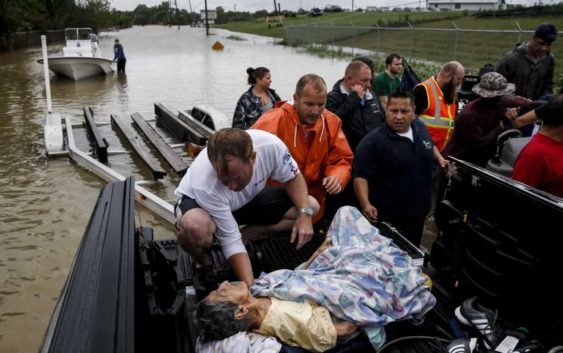- Weather Impact Alert: Cold front could trigger severe weather in Houston area this weekend | See timeline
- Violent storms cut through the South and Midwest, spawning tornadoes and killing 3
- Above-normal active 2025 hurricane season predicted by Colorado State University
- Cold front could trigger severe weather in Houston area this weekend | Timeline for potential storms
- Severe weather possible for Houston this weekend | Weather Impact Alert issued
Hurricane Harvey flooding victims get their day in federal court

-
A rescuer moves Paulina Tamirano, 92, from a boat to a truck bed as people evacuate from the Savannah Estates neighborhood as Addicks Reservoir surpasses capacity due to near constant rain from Tropical Storm Harvey Tuesday, Aug. 29, 2017 in Houston. ( Michael Ciaglo / Houston Chronicle )
A rescuer moves Paulina Tamirano, 92, from a boat to a truck bed as people evacuate from the Savannah Estates neighborhood as Addicks Reservoir surpasses capacity due to near constant rain from Tropical Storm
Photo: Michael Ciaglo, Staff / Houston Chronicle
A rescuer moves Paulina Tamirano, 92, from a boat to a truck bed as people evacuate from the Savannah Estates neighborhood as Addicks Reservoir surpasses capacity due to near constant rain from Tropical Storm Harvey Tuesday, Aug. 29, 2017 in Houston. ( Michael Ciaglo / Houston Chronicle )
A rescuer moves Paulina Tamirano, 92, from a boat to a truck bed as people evacuate from the Savannah Estates neighborhood as Addicks Reservoir surpasses capacity due to near constant rain from Tropical Storm
Photo: Michael Ciaglo, Staff / Houston Chronicle
Residents and business owners whose properties flooded above the Barker and Addicks reservoirs following Hurricane Harvey will have their day in Houston federal court beginning Monday in a lawsuit seeking damages from U.S. Army Corps of Engineers for using their land to detain water.
UNWELCOME SURPRISE Many homeowners unaware they lived in reservoir ‘flood pools’
The case in the U.S. Court of Claims focuses on about a dozen test-case properties that the parties agreed upon that flooded in the wake of the historic storm. The first batch of lawsuits to go to trial are known as the upstream properties, which were inundated as water built up in two flood pools west of Houston.
Hundreds have sued the federal government for damages, and the window of opportunity for others to join remains open.
NO WARNINGS: For buyers within ‘flood pools,’ no warnings from developers, public officials
The county and city approved the construction of 30,000 suburban homes and businesses in Katy and west Houston on the edges of Addicks and Barker reservoirs, inside invisible lake beds that government and private engineers had long predicted would be inundated in an extreme storm. More than 9,000 of those structures flooded during Hurricane Harvey, records show.
A large group of homeowners has sued the U.S. Army Corps of Engineers , which operates the dams, contending that in allowing the reservoirs to spill into dozens of neighborhoods, the government seized their property without compensation. Many had no idea — until Harvey struck — that their homes were within the reservoirs’ footprint, in areas engineers call “flood pools.”
SECRET PREDICTIONS: Record reservoir flood predictions kept secret before Hurricane Harvey hit Houston
At least 4,000 houses, apartment buildings and businesses west of the Barker Reservoir were damaged during Harvey, according to preliminary estimates by county officials. In the hardest-hit neighborhoods, floodwater rose more than 5 feet and did not recede for a week or more.
The trial is expected to last two weeks and will likely include a visit by the federal judge, lawyers and experts to the site of the flooding.
gabrielle.banks@chron.com